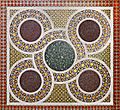Quincunx facts for kids

A quincunx is a special pattern made of five points. Imagine a square or a rectangle, and then put one more point right in the middle. That's a quincunx! You see this pattern a lot, like on the number five side of a die, on playing cards, and on dominoes.
What Does "Quincunx" Mean?
The word "quincunx" comes from ancient Rome. It was the name of a Roman coin made around 211–200 BC. This coin was worth five-twelfths of another Roman coin called an "as." The word "quinque" means five, and "uncia" was a unit of measurement.
Sometimes, these Roman quincunx coins had five dots on them to show their value. However, these dots weren't always arranged in the cross-like quincunx pattern we know today. Over time, the word started being used to describe the pattern itself, especially for things like planting trees in an orchard.
Where Can You See Quincunx Patterns?
Quincunx patterns pop up in many different places. Here are some cool examples:

- Flags and Symbols: In heraldry, which is the study of coats of arms and flags, groups of five items are often placed in a quincunx shape. For example, the flag of the Solomon Islands has five stars arranged in this pattern. These stars stand for the five main island groups in the country.
- Orchards: Farmers often plant trees in an orchard using a quincunx pattern. This helps them make the best use of space.
- Science and Math:
- A famous science tool called the "bean machine" (also known as a quincunx) shows how probability works. It has pins arranged in a quincunx pattern.
- In computer graphics, the quincunx pattern helps make images look smoother. It's used in a technique called "multisample anti-aliasing."
- Buildings and Art:
- Some buildings have a "quincuncial plan." This means their design has nine sections, with the middle one and the four corner ones covered by domes. This creates a quincunx shape with the domes.
- In ancient Khmer architecture, like at Angkor Wat, temple towers are sometimes arranged in a quincunx. This represents the five peaks of a mythical mountain called Mount Meru.
- The quincunx is also a common design in beautiful stone artwork called Cosmatesque inlay.
- Maps: A "quincuncial map" is a special type of map projection. It shows the Earth's poles at the center and four corners of a square, forming a quincunx.
- Tattoos: A quincunx pattern is sometimes used as a tattoo, known as the five dots tattoo. It can represent different ideas, like a group of close friends or standing strong on your own. The famous inventor Thomas Edison even had this pattern tattooed on his forearm!
- Rockets: The first two parts of the powerful Saturn V rocket, which took astronauts to the Moon, had their engines arranged in a quincunx pattern.
- Sports: A baseball diamond forms a quincunx. The four bases and the pitcher's mound create this five-point shape.
Images for kids
-
12th-century Cosmatesque mosaic in the Cappella Palatina, Palermo, Sicily
See also
 In Spanish: Quincunce para niños
In Spanish: Quincunce para niños







